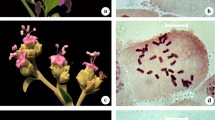Abstract
Karyological preparations were made from the testisacs of three medicinal leech species Hirudo medicinalis Linnaeus, 1758, H. verbana Carena, 1820 and H. orientalis Utevsky & Trontelj, 2005 . The samples originated from different populations in Azerbaijan, Kazakhstan, Russian Federation, Ukraine and Uzbekistan. The chromosome numbers were determined both from mitotic and meiotic stages of spermatogenesis using the propionic haematoxylin staining technique. All three species were found to have different haploid chromosome numbers: H. medicinalis 14, H. verbana 13 and H. orientalis 12, thus corroborating the validity of these taxa. The chromosomes can be classified as meta-, submetacentric and acrocentric. The chromosome numbers obtained are similar to that of the related species Haemopis sanguisuga (Linnaeus, 1758), which has 13 pairs.







Similar content being viewed by others
References
Baskova, I. P., Kostrjukova, E. S., Vlasova, M. A., Kharitonova, O. V., Levitskiy, S. A., Zavalova, L. L., et al. (2008). Proteins and peptides of the salivary gland secretion of medicinal leeches Hirudo verbana, H. medicinalis, and H. orientalis. Biochemistry (Moscow), 73, 315–320.
Frankham, R., Ballou, J. D., & Briscoe, D. A. (2004). A primer of conservation genetics. Cambridge: Cambridge University Press, 220 pp.
Hechtel, F. O. P., & Sawyer, R. T. (2002). Toward a taxonomic revision of the medicinal leech Hirudo medicinalis Linnaeus, 1758 (Hirudinea: Hirudinidae): re-description of Hirudo troctina Johnson, 1816 from North Africa. Journal of Natural History, 36, 1269–1289.
Henderson, S. A., & Lu, B. C. (1968). The use of hematoxylin for squash preparations of chromosomes. Stain Technology, 43, 233–236.
Klymenko, V. V. (1972). The use of propionic hematoxylin for counting cells in insect eggs. Ontogenez, 3, 326–329. (In Russian).
Kovalenko, N. V., Doroshenko, K. A., Klimenko, V. V., Utevsky, A. Y., & Utevsky, S. Y. (2007). The use of propionic hematoxylin in a study of the germ line of the medicinal leech Hirudo medicinalis (Clitellata, Hirudinea). Visnyk Kharkivskogo Natsionalnogo Universytetu imeni V. N. Karazina, Seriya Biolohiyi, 788(6), 44–47. (In Russian).
Laufer, A. S., Siddall, M. E., & Graf, J. (2008). Characterization of the digestive-tract microbiota of Hirudo orientalis, a European medicinal leech. Applied and Environmental Microbiology, 74, 6151–6154.
Linnaeus, C. (1758). Systema naturae per regna tria naturae, secundum classes, ordines, genera, species, cum characteribus, differentiis, synonymis, locis (Vol. 1, p. 823). Holmiae: Impensis Direct. Laurentii Salvii.
Moquin-Tandon, A. (1827). Monographie de la famille des Hirudineés. Montpellier: Maison de Commerce, 151 pp.
Moquin-Tandon, A. (1846). Monographie de la famille des Hirudineés. Paris: J.-B. Bailliére, 448 pp.
Nesemann, H., & Neubert, E. (1999). Annelida: Clitellata: Branchiobdellida, Acanthobdellea, Hirudinea. In Süsswasserfauna von Mitteleuropa (Vol. 6/2, 178 pp). Heidelberg, Berlin: Spektrum Akademischer Verlag.
Petrauskienė, L. (2008). The use of the medicinal leech (Hirudo sp.) in ecotoxicological and other scientific research—a short review. Lauterbornia, 65, 163–175.
Sawyer, R. T. (1986). Leech biology and behaviour. Oxford: Oxford University Press, 370 pp.
Siddall, M. E., Trontelj, P., Utevsky, S. Y., Nkamany, M., & Macdonald, K. S. III. (2007). Diverse molecular data demonstrate that commercially available medicinal leeches are not Hirudo medicinalis. Proceedings of the Royal Society B, 274, 1481–1487.
Tong, Y., Tiehui, W., & Zhengke, G. (1997). Chromosome number and characteristics of a Hirudinidae leech Hirudo nipponia. Zoological Research, 18, 26, 32, 50.
Trontelj, P., Sotler, M., & Verovnik, R. (2004). Genetic differentiation between two species of the medicinal leech, Hirudo medicinalis the neglected H. verbana, based on random amplified polymorphic DNA. Parasitology Research, 94, 118–124.
Trontelj, P., & Utevsky, S. Y. (2005). Celebrity with a neglected taxonomy: molecular systematics of the medicinal leech (genus Hirudo). Molecular Phylogenetics and Evolution, 34, 616–624.
Utevsky, S. Y., & Trontelj, P. (2005). A new species of the medicinal leech (Oligochaeta, Hirudinida, Hirudo) from Transcaucasia and an identification key for the genus Hirudo. Parasitology Research, 98, 61–66.
Utevsky, S. Y., Utevsky, A. Y., & Utevskaya, O. M. (1998). A find of the officinal medicinal leech Hirudo medicinalis f. officinalis in Ukraine. Vestnik zoologii, 32, 37. (In Russian).
Utevsky, S. Y., Zinenko, A. I., Atemasov, A. A., Huseynov, M. A., Utevska, O. M., & Utevsky, A. Y. (2008). New information on the distribution of the medicinal leech (genus Hirudo) in the Iberian Peninsula, the Caucasus and Central Asia. Lauterbornia, 65, 119–130.
Vitturi, R., Libertini, A., Armetta, F., Sparacino, L., & Colomba, M. S. (2002). Chromosome analysis and FISH mapping of ribosomal DNA (rDNA). telomeric (TTAGGG)n and (GATA)n repeats in the leech Haemopis sanguisuga (L.) (Annelida: Hirudinea). Genetica, 115, 189–194.
Wendrowsky, V. (1928). Über die Chromosomencomplexe der Hirudineen. Zeitschrift für Zellforschung und Mikroskopische Anatomie, 8, 153–175.
Yermakov, S. V., Basanova, A. V., & Husnutdinova, C. V. (2006). Crossbreeding of oriental and officinal subspecies of the medicinal leech in laboratory conditions. In Hirudo—2006. Materials of the IX research and practical conference of the association of Hirudologists of Russia, 18–20 September 2006. Balakovo (pp. 3–4).
Zapkuvienė, D., & Petrauskienė, L. (2000). Medicinine dėlė: anatomija, fiziologija, ekologija. Vilnius: Ekologijos Institutas, 160 pp.
Acknowledgements
This research was supported by INTAS grant No. 05-1000008-8147. We are thankful to Andrei Utevsky for providing us with the pictures of the medicinal leeches (Fig. 1).
Author information
Authors and Affiliations
Corresponding author
Rights and permissions
About this article
Cite this article
Utevsky, S., Kovalenko, N., Doroshenko, K. et al. Chromosome numbers for three species of medicinal leeches (Hirudo spp.). Syst Parasitol 74, 95–102 (2009). https://doi.org/10.1007/s11230-009-9198-2
Received:
Revised:
Accepted:
Published:
Issue Date:
DOI: https://doi.org/10.1007/s11230-009-9198-2




